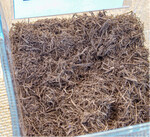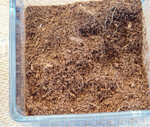How peat replacement can work
The peat reduction strategy drawn up by the German Federal Ministry of Food and Agriculture (BMEL) as part of the Climate Protection Plan 2050 envisages the greatest possible elimination of peat in commercial horticulture by 2030. This also poses challenges for the nursery sector. But there is support and initial results are showing promise.
- Published on

On behalf of the BMEL, the Agency for Renewable Resources (FNR) promotes projects for the sustainable production, processing and provision of peat substitutes and invited nurseries to a workshop as part of the event series "Peat reduction in commercial horticulture". The focus was on the transfer of practice, the exchange and networking of players in horticulture and, in particular, problems faced by producers.
The Central Horticultural Association (ZVG) supports the workshop series as a cooperation partner. Dr. Hans Joachim Brinkjans, deputy secretary general of ZVG, emphasized that the switch to peat-reduced or even peat-free substrates is voluntary. The BMEL intends to continue to adhere to this.
Hajo Hinrichs, Vice President of the Association of German Nurseries (BdB), would like to see long-term research work. Especially for the nursery sector, he said, research projects are often far too short. He also pointed out the need to involve consumers in the issue of peat-reduced substrates.
Politicians need to make sensible, long-term decisions based on facts in order to adapt to the situation and provide all employees with a long-term livelihood. For this reason, too, he said, projects together with the scientific community are important in order to provide politicians with decision-making aids.Three steps to gate reduction
With their permanent crops, nurseries are subject to a special challenge when it comes to peat reduction. Pia Bunger, Lower Saxony Chamber of Agriculture (LWK), presented the model and demonstration project for the practical introduction of peat-reduced substrates in tree nurseries (ToSBa) and the latest findings from the practical trials carried out in ten farms. The regional coordinator ToSBa is in charge of five nurseries in the Ammerland region. Another five nurseries are supervised in the model region of Pinneberg by coordinators there from the LWK Schleswig-Holstein. The ten farms form a wide spectrum of nursery operations with different crops and cultivation methods. The first cultivation trials in the TosBa project, which began in 2020, took place in 2021. The project target is a maximum of 50% peat in the substrates.
Some farms started with 100% peat substrate, and in the second step nine out of ten farms have already reduced peat by 50%. One farm is on the way to peat-free production.
In most cases, the first step of a peat reduction to 20 to 30 % peat substitute was quite unproblematic, usually with only one substitute in the form of wood fiber. Since wood fiber is about as expensive as peat, the new substrates hardly cost any more. In most cases, this first step succeeded without any adjustments in crop management. The wood fiber fixes nitrogen, which should be balanced with fertilization. Irrigation intervals need to be adjusted in some cases and increased a little. "Any nursery can take this first step, and we encourage everyone to do so," Bunger said in an initial summary. The practical examples shown of quite different nursery cultures in peat substrate and peat-reduced substrate showed hardly any differences, and in some cases there was even a tendency for more positive culture results. Forsythia cultivated in 30 % wood fiber showed better drainage behavior due to the wood fiber. The plants were larger and better rooted. Another positive example was larger growing nursery plants in a substrate of 70% peat, 15% wood fiber and 15% bark humus compared to a substrate of 85% peat without bark humus. It is possible that the additional nutrients from the bark humus or the altered air balance led to the better growth.
However, for Lonicera, the substrate with 15% wood fiber and 15% bark humus resulted in poorer drainage, visible on wetted areas of the container area. Possibly there were overlaps of the circular sprinklers here.Second step: Pay attention to drainage
The second step is to achieve a 50% gate reduction, which requires more than just wood as a substitute. Other substitutes such as substrate compost, bark humus, coir and other mixing partners are needed. This conversion phase usually does not work without problems. For example, some plants were smaller with increasing compost content. The reason could be the poorer drainage caused by compost.
High potassium phosphate levels in soil samples showed salt stress in one experimental variant. This resulted in somewhat smaller and less branched plants.
The substrate mixture solutions must be individually adapted to the farm and the conditions. As a rule, crop management, in any case fertilization, must be adapted. For example, the significant nutrients from the substrate compost must be taken into account.
"The cost also goes up in this step," Bunger reported. The additional substrate feedstocks are more expensive than peat. Good advice and substrate analyses are necessary in order to be able to intervene quickly in the cultivation process.
In this changeover phase, somewhat smaller plants can be expected under certain circumstances. Trials with Viburnum or Cornus alba sibirica, among others, produced good cultivation results with 65 or 70% peat in the substrate. Ilex crenata and cherry laurel also grew well in substrates with 40 or 50% peat. Thuja and privet also showed no differences when grown with 75 or only 40 % peat in the substrate.
Even bog bed young plants grew well in a substrate of 50 % peat, 20 % wood fiber and 10 % each of perlite, bark humus and coconut pulp.Third step: Little experience, higher risk and more costs
One farm already uses only 20% peat. The lower the peat percentage, the larger the portfolio of peat substitutes. "It is important to have a high, consistent quality of raw materials," says Bunger. Regular substrate analyses are essential to avoid disasters.
So far, little empirical data is available for this third step of peat reduction. "In any case, higher crop risk, rising costs for substrate, fertilization and irrigation, as well as more intensive supervision are to be expected," Bunger opined.Allow enough time
What is clear is that sufficient time must be planned for the individual steps of peat reduction. There are already clear differences between a rainy year and one characterized by drought and heat. The higher the peat replacement, the more the crop management needs to be adjusted in terms of fertilization and irrigation. Regular substrate sampling is important for crop safety. Consulting offers of substrate companies, advisory rings and LWKs should be used. Training of employees must not be forgotten. This is because the coloring and weights of the new substrates are different and previous experience values have to be reclassified.
The additional costs must also be taken into account. While a substrate with 100% peat costs about 35 €/m², the cost of a substrate with about 80% peat replacement rises to about 78 €/m². Extrapolated to the required quantity of a farm, this results in enormous additional costs - for the substrate alone. Higher cultivation costs due to adapted fertilization and irrigation or even the increased cultivation risk are not yet included.
It remains to be feared that the farms will be left with the additional costs. A positive market environment makes this bearable. If the market and the financial operating situation are poor, it is precisely this relatively small increase in costs per plant that can lead to financial ruin.
Currently, peat-free nursery production is not possible, according to Bunger. The availability of substrate feedstocks is already very limited. Lack of experience with the new substrates means lack of crop safety with much more expensive substrates. Nutrient and pH issues with peat substitutes need further investigation.
There is no CO 2 -neutral peat substitute. Perhaps the end product should be seen, the plant, which ends up sequestering CO 2 , according to the discussion.
What is needed is all possible peat feedstocks to have enough in total if peat is not available in the future.
Hope dies last. One advantage could be P- and K-rich feedstocks to end up with only nitrogen fertilizer.
The use of digestate could be a long-term alternative. However, these are again in competition with agriculture and are therefore difficult to calculate.
The challenges affect everyone in the industry, soil manufacturers, producers, retailers and consumers, who also need guidance on how to handle the new substrates.




